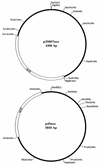Generalized transduction of small Yersinia enterocolitica plasmids
- PMID: 10473387
- PMCID: PMC99712
- DOI: 10.1128/AEM.65.9.3862-3866.1999
Generalized transduction of small Yersinia enterocolitica plasmids
Abstract
To study phage-mediated gene transfer in Yersinia, the ability of Yersinia phages to transduce naturally occurring plasmids was investigated. The transduction experiments were performed with a temperate phage isolated from a pathogenic Yersinia enterocolitica strain and phage mixtures isolated from sewage. Small plasmids (4.3 and 5.8 kb) were transduced at a frequency of 10(-5) to 10(-7)/PFU. However, we could not detect the transduction of any indigenous virulence plasmid (ca. 72 kb) in pathogenic Yersinia strains. Transductants obtained by infection with the temperate phage were lysogenic and harbored the phage genome in their chromosomes.
Figures




Similar articles
-
Yersinia Phages and Food Safety.Viruses. 2019 Nov 28;11(12):1105. doi: 10.3390/v11121105. Viruses. 2019. PMID: 31795231 Free PMC article. Review.
-
PY54, a linear plasmid prophage of Yersinia enterocolitica with covalently closed ends.Mol Microbiol. 2003 May;48(4):989-1003. doi: 10.1046/j.1365-2958.2003.03458.x. Mol Microbiol. 2003. PMID: 12753191
-
Comparative study of temperate bacteriophages isolated from Yersinia.Syst Appl Microbiol. 2000 Dec;23(4):469-78. doi: 10.1016/S0723-2020(00)80020-X. Syst Appl Microbiol. 2000. PMID: 11249016
-
Yersinia enterocolitica-Specific Infection by Bacteriophages TG1 and ϕR1-RT Is Dependent on Temperature-Regulated Expression of the Phage Host Receptor OmpF.Appl Environ Microbiol. 2016 Aug 15;82(17):5340-53. doi: 10.1128/AEM.01594-16. Print 2016 Sep 1. Appl Environ Microbiol. 2016. PMID: 27342557 Free PMC article.
-
Role of a plasmid in the pathogenicity of Yersinia species.Curr Top Microbiol Immunol. 1985;118:29-51. doi: 10.1007/978-3-642-70586-1_3. Curr Top Microbiol Immunol. 1985. PMID: 3902382 Review. No abstract available.
Cited by
-
Unexpected aspects in the dynamics of horizontal gene transfer of prokaryotes: the impact of outer membrane vesicles.Wien Med Wochenschr. 2018 Sep;168(11-12):307-313. doi: 10.1007/s10354-018-0642-2. Epub 2018 Aug 6. Wien Med Wochenschr. 2018. PMID: 30084090 Free PMC article.
-
The extended mobility of plasmids.Nucleic Acids Res. 2025 Jul 19;53(14):gkaf652. doi: 10.1093/nar/gkaf652. Nucleic Acids Res. 2025. PMID: 40694848 Free PMC article. Review.
-
The repA gene of the linear Yersinia enterocolitica prophage PY54 functions as a circular minimal replicon in Escherichia coli.J Bacteriol. 2005 May;187(10):3445-54. doi: 10.1128/JB.187.10.3445-3454.2005. J Bacteriol. 2005. PMID: 15866931 Free PMC article.
-
Isolation and Identification of Two Novel Escherichia coli Bacteriophages and Their Application in Wastewater Treatment and Coliform's Phage Therapy.Jundishapur J Microbiol. 2015 Mar 21;8(3):e14945. doi: 10.5812/jjm.14945. eCollection 2015 Mar. Jundishapur J Microbiol. 2015. PMID: 25834715 Free PMC article.
-
Yersinia Phages and Food Safety.Viruses. 2019 Nov 28;11(12):1105. doi: 10.3390/v11121105. Viruses. 2019. PMID: 31795231 Free PMC article. Review.
References
-
- Ackerman H W, DuBow M S, Jarvis A W, Jones L A, Krylov V N, Maniloff J, Rocourt J, Safferman R S, Schneider J, Seldin L, Sozzi T, Stewart P R, Wequin M, Wünsche L. The species concept and its application to tailed phages. Arch Virol. 1992;124:69–82. - PubMed
-
- Bergan T, Norris J R. Bacteriophage typing of Yersinia enterocolitica. Methods Microbiol. 1978;12:25–36.
-
- Bergh O, Borsheim K Y, Bratbak G, Heldal M. High abundance of viruses found in aquatic environments. Nature. 1989;340:467–468. - PubMed
MeSH terms
Substances
LinkOut - more resources
Full Text Sources

